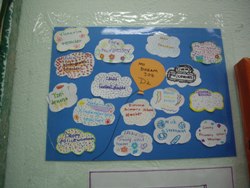TPL__SYSTEM_MESSAGE
My Pictures
- Λεπτομέρειες
- Κατηγορία: Uncategorised
- Δημοσιεύτηκε στις Τετάρτη 02 Μαΐου 2012 08:08
- Γράφτηκε από τον/την Super User
- Εμφανίσεις: 124
Various pictures related to the teaching of English.


My documents
- Λεπτομέρειες
- Κατηγορία: Uncategorised
- Δημοσιεύτηκε στις Τρίτη 01 Μαΐου 2012 21:38
- Γράφτηκε από τον/την Super User
- Εμφανίσεις: 138
Various documents related to the teaching of English.
Which classroom?
- Λεπτομέρειες
- Κατηγορία: Uncategorised
- Δημοσιεύτηκε στις Παρασκευή 13 Απριλίου 2012 15:08
- Γράφτηκε από τον/την Super User
- Εμφανίσεις: 142
Let's consider the type of classroom that existed in Victorian Britain. It looked like that:

Let's now compare it to the new type of classroom piloted in Sweden, the open classroom which looks like that:

Traditional classrooms are design for a teacher centric delivery mode. 21st Century learners are collaborators and communicators. So the classroom must be designed to enable group collaboration. They must have the flexibility in furnishings and technology to be rearranged with ease and speed. Switching rapidly between individual and groups, presentation, communication and collaborative modes. From these grouping learners and educators must be able to connect, collaborate, share and report - projection and video conference, present and report back. That is to respond to the 21st c learners' needs the classroom must provide opportunities to learners with the following characteristics :
- Technology literate and adept
- Media savvy
- Flexible and dynamic
- multitasking
- communicators and collaborators
- interactive and networked
- reflective and critical
- instant
- creative and adaptive
- student centric, life long learners & anywhere anytime learners
- have Multimodal learning styles
My videos
- Λεπτομέρειες
- Κατηγορία: Uncategorised
- Δημοσιεύτηκε στις Τρίτη 01 Μαΐου 2012 21:35
- Γράφτηκε από τον/την Super User
- Εμφανίσεις: 235
Videos related to the teaching of English.
A great 3-minute prize winning story on heroism, friendship and anti-racism.
Collaboration
- Λεπτομέρειες
- Κατηγορία: Uncategorised
- Δημοσιεύτηκε στις Παρασκευή 13 Απριλίου 2012 14:46
- Γράφτηκε από τον/την Super User
- Εμφανίσεις: 243
The 21st century is a the age of collaboration as well as the Information Age. 21st Century students, our digital natives, are collaborative. So to prepare our students, our teaching should also model collaboration. A vast array of collaborative tools are available to ? wikis, classroom blogs, collaborative document tools,social networks, learning management systems ? Many at no costs. According to the UNESCO, the Four Pillars of Education are :
- learning to know
- learning to do
- learning to live together
- learning to be


